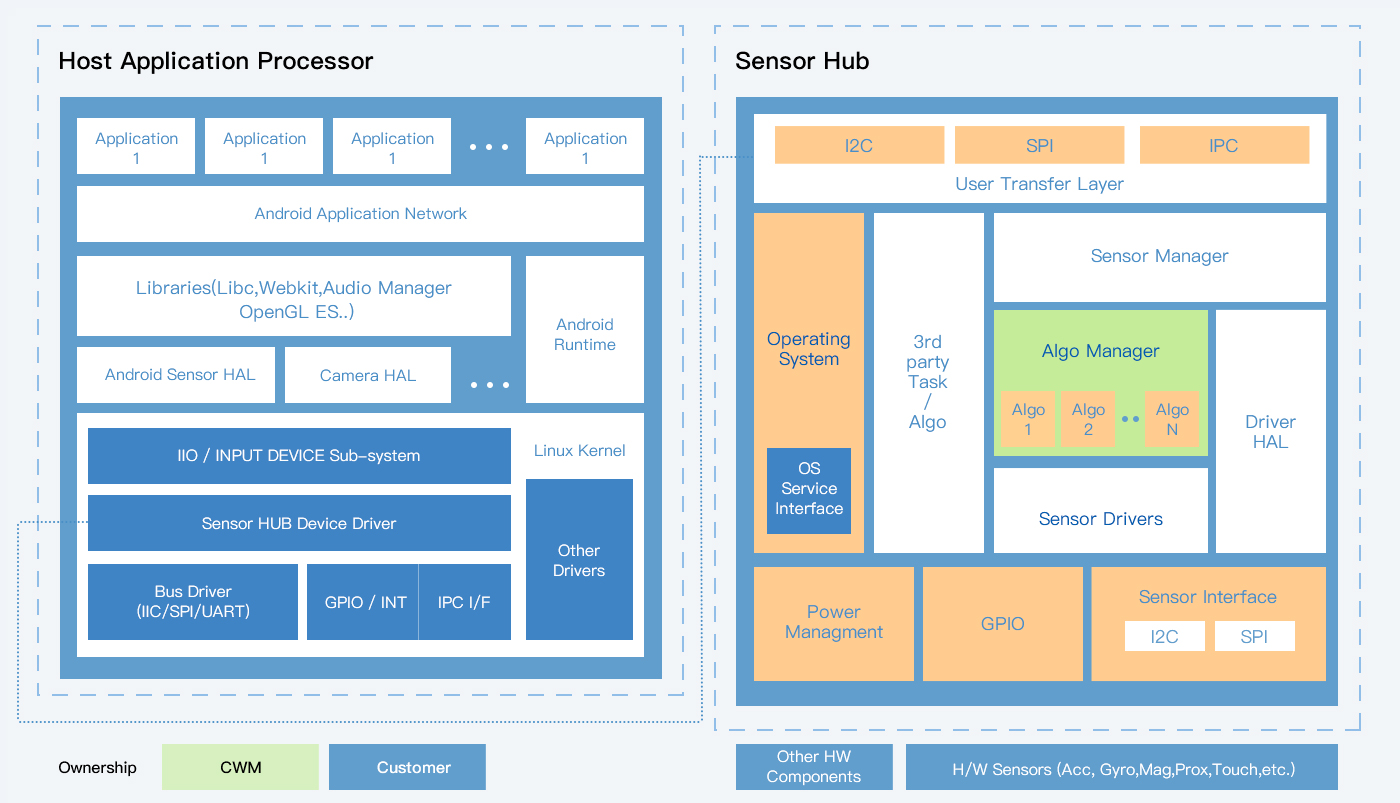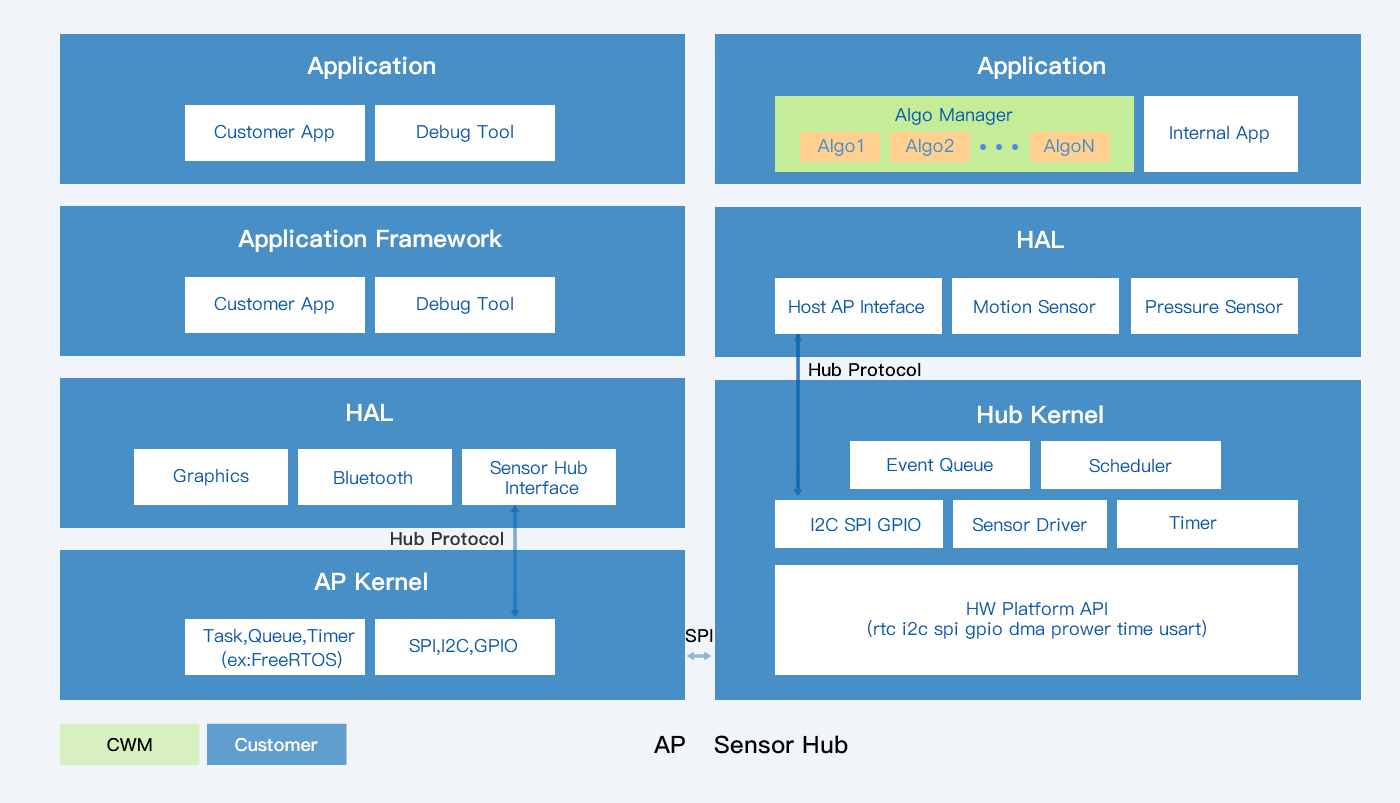

9-axis Inertial Motion Sensor
Our 9-axis sensor fusion algorithm measures 3-axis G-sensor, 3-axis gyroscope and 3-axis magnetic field sensor in a space. It conquers the disadvantages of using a single traditional sensor and fulfills the principle of accurate aerial capturing.

9-axis motion output

Absolute position

Reduced magnetic interference

Zero singularity

We provide a full set of sensor fusion algorithm for Smartphones. Our solutions focus on strong functional optimization for mainstream hardware platforms (e.g. Qualcomm, Spreadtrum & Mediatek), and support various sensors produced by different sensor manufacturers. We collect data through the accelerometer, gyroscope and magnetometer to output instant and absolute position of the device. Furthermore, our algorithm provides stable and compatible solutions on the Android operating system.


No
Sensor
Description
01
CWM Accelerometer
An accelerometer sensor reports the acceleration of the device along the 3 sensor axes.
02
CWM Magnetic field sensor
A magnetic field sensor (also known as magnetometer) reports the ambient magnetic field, as measured along the 3 sensor axes.
03
CWM Magnetic field uncalibrated
An uncalibrated magnetic field sensor reports the ambient magnetic field together with a hard iron calibration estimate.
04
CWM Gyroscope
A gyroscope sensor reports the rate of rotation of the device around the 3 sensor axes.
05
CWM Gyroscope uncalibrated
An uncalibrated gyroscope reports the rate of rotation around the sensor axes without applying bias compensation to them, along with a bias estimate.
06
CWM Light
A light sensor reports the current illumination in SI lux units.
07
CWM Pressure
A pressure sensor (also known as barometer) reports the atmospheric pressure in hectopascal (hPa).
08
CWM Temperature
This sensor provides the device temperature in degrees Celsius.
09
CWM Ambient temperature
This sensor provides the ambient (room) temperature in degrees Celsius.
10
CWM Proximity
A proximity sensor reports the distance from the sensor to the closest visible surface.
11
CWM Relative humidity
A relative humidity sensor measures relative ambient air humidity and returns a value in percent.
12
CWM Heart Rate
A heart rate sensor reports the current heart rate of the person touching the device.
13
CWM Orientation
An orientation sensor reports the attitude of the device.
14
CWM Gravity
A gravity sensor reports the direction and magnitude of gravity in the device's coordinates.
15
CWM Linear acceleration
A linear acceleration sensor reports the linear acceleration of the device in the sensor frame, not including gravity.
16
CWM Rotation vector
A rotation vector sensor reports the orientation of the device relative to the East-North-Up coordinates frame.
17
CWM Game rotation vector
A game rotation vector sensor is similar to a rotation vector sensor but not using the geomagnetic field.
18
CWM Geomagnetic rotation vector
A geomagnetic rotation vector is similar to a rotation vector sensor but using a magnetometer and no gyroscope.
19
CWM Significant motion
A significant motion detector triggers when the detecting a “significant motion”: a motion that might lead to a change in the user location.
20
CWM Step detector
A step detector generates an event each time a step is taken by the user.
21
CWM Step counter
A step counter reports the number of steps taken by the user since the last reboot while activated.
22
CWM Tilt detector
A tilt detector generates an event each time a tilt event is detected. A tilt event is defined by the direction of the 2-seconds window average gravity changing by at least 35 degrees since the activation or the last event generated by the sensor.
23
CWM Wake up
A wake up gesture sensor enables waking up the device based on a device specific motion.
24
CWM Glance
A glance gesture sensor enables briefly turning the screen on to enable the user to glance content on screen based on a specific motion.
25
CWM Pick up
A pick-up gesture sensor sensor triggers when the device is picked up regardless of wherever is was before (desk, pocket, bag).
No
Sensor
Description
26
CWM Shake
Shake the device twice.
27
CWM Flip
Flip the device when putting on the table to mute.
28
CWM Twist
Twist the device twice using the wrist.
29
CWM Pocket mode
Detect if the device is in the pocket.
30
CWM Hand up
Pick up the device from the table to the ear to pick up the phone.
31
CWM Hand down
Put down the device from the ear to the table to hang up the phone.
32
CWM Rear camera
Pick up the device and stop in landscape mode (keep in 1 second).
33
CWM Front camera
Pick up the device and stop in portrait mode (keep in 1 second).
34
CWM Proximity screen on
Wave the hand above the device on the table to wake up the device.
35
CWM Fall
Fall detection.
36
CWM Reserve Sensor A
Reserve pedometer that outputs step count, walking distance, calories, status and etc.
37
CWM Context awareness
Activity recognition tries to detect the user's current physical activity, such as walking, running, and etc.
38
CWM Static detector
Detect if the device is static.
39
CWM Face up
The screen of the device faces upward.
40
CWM Face down
The screen of the device faces downward.
41
CWM Bring to see
A sensor of this type triggers when the device face is tilted towards the user.
42
CWM AutoPickUp
Detection of somatosensory answer, flip mute and reject negative.
43
CWM PDR_with_GPS
PDR compensate GPS.
44
CWM phone fall
phone fall
45
CWM Taking elevator
搭乘电梯
No
Function
ROM(Bytes)
RAM(Bytes)
DMIPS
01
Linear acceleration
10,552
2,384
2.76
02
Gravity
10,552
2,384
2.76
03
Rotation vector
10,552
2,384
2.76
04
Game rotation vector
10,552
2,384
2.663
05
Geomagnetic rotation vector
10,552
2,384
0.813
06
Step detector
2,264
336
0.6281
07
Step counter
6,740
1,452
0.8325
08
Significant motion
2,506
724
0.2173
09
Stationary Detect
2,264
336
0.6281
10
Motion Detect
940
300
0.4327
11
Device Orientation
1,140
48
0.6224
12
Tilt Detector
1,336
142
0.3616
13
Wake Gesture
2,452
80
0.2899
14
Glance Gesture
3,542
176
0.6235
15
Pickup Gesture
3,542
176
0.6235
No
Function
ROM(Bytes)
RAM(Bytes)
DMIPS
01
Pedometer
9,244
1,036
0.7322
02
Activity recognition (Still,walking,running)
5,084
2,880
0.9796
03
Floor climbed
6,740
1,452
0.8325
04
Pocket Mode
860
52
0.0799
05
Flip
3,346
80
0.6361
06
Shake
1,700
448
0.1983
07
Tap
5,204
1,130
0.9792
08
Twist
1,062
114
0.1001
09
Hand up
4,584
282
0.2152
10
Face up/Face down
1,866
80
0.3185
11
Driving/Taking train recognition
5,084
2,880
0.9796
12
Taking elevator
2,012
472
0.2643
13
Phone fall
4,550
480
0.2963
lower power consumption:Reduce over 75% GPS run time
Prevent GPS location drifting from external interference
Smooth trajectory during low speed exercises. (Walking case)